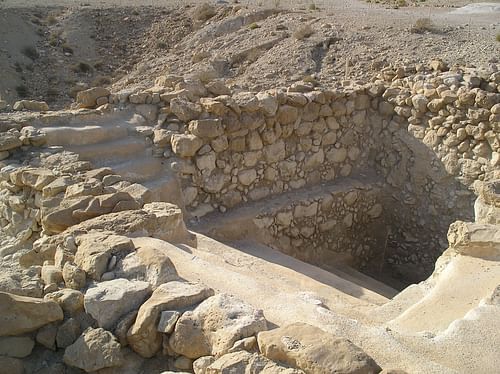During the period of early Judaism (6th century BCE - 70 CE), Judean religion began to develop ideas which diverged significantly from 10th-to-7th-centuries BCE Israelite and Judean religion. In particular, this period marks a significant movement towards monotheism, the codification of traditions central to religious identity (i.e. the Hebrew Bible), and new ideas regarding the worship of Yahweh.
Cultural influences
With the height of power for the Judean and Israelite kingdoms in the 8th century BCE, Jerusalem became the site of the central temple for Judean and Israelite religion and, consequently, politics. It was a common understanding throughout the ancient world that the temple, and thereby the city, was secure so long as the temple was well-maintained and deity was pleased with the people. In the early 6th century BCE, though, this traditional idea was challenged. In the Jerusalem temple, valuables were seized twice by non-Judean kings and then it was destroyed in 586 BCE by the Neo-Babylonian empire. The fracturing of this traditional notion forced Judeans to reconsider and reconceptualize their religious ideas.
Additionally, with the rise of the Persian empire in the late 6th century BCE, people groups originally exiled by the Neo-Assyrians and Neo-Babylonians were permitted to return to their homelands. Consequently, wealthy Judeans were permitted to return to Judah, and they rebuilt the temple in Jerusalem. In this period, though, literary evidence also indicates the existence of Judean communities in Egypt, Mesopotamia, Samaria, and Judah (Yehud), commonly referred to as the Jewish diaspora. Due to the geographic spread of Judeans, it is evident that various Judean communities were enabled to develop in distinct ways. So, there was no single, proper religious practice of Judaism. Though united with regard to the central position of the deity Yahweh, there were many ideas of what constituted correct worship. For this reason, some scholars reference Judean religion during this period as early Judaisms (note the plural).
From the 4th century BCE, early Judaism experienced further developments through intercultural exchange with the Hellenistic and the Roman world. Particularly important is that Judeans in Judah were politically independent for a few years during this period. Two major consequences of this political independence were the significant religious developments and the destruction of the 2nd temple in Jerusalem in 70 CE, the one which had been rebuilt in the 6th century BCE. Most scholars consider this event as the end of early Judaism; from 70 CE forward, Jewish religion falls under the category of “Rabbinic Judaism.”
Monotheism
The destruction of the Jerusalem temple in 586 BCE challenged traditional notions about the inviolability of Jerusalem. Consequently, Judeans reconsidered the issue of Yahweh's rule during the Persian period (the late 6th century BCE). This is attested in the biblical book of Isaiah. Scholars typically divide Isaiah into two sections on the basis of content and language: 1st Isaiah is chapters 1-39 and 2nd Isaiah is chapters 40-66, with the latter typically dated to the Persian period. In Isaiah 44:9-20, the author speaks against non-Yahweh centered worship of other deities, specifically worship via idols: “They [the idols] do not know, nor do they comprehend; for their eyes are shut, so that they cannot see, and their minds as well, so that they cannot understand” (New Oxford Annotated Study Bible).
In Mesopotamia, deities were often worshipped via a statue with an understanding the presence of the deity resided in that statue. Consequently, by regarding statues as lifeless idols, Isaiah seems to be expressing that the deities were not actually present in the statues. Therefore, Many scholars view this as some of the earliest evidence of Judean monotheism. This idea is developed further in Isaiah 45:1-7, where Yahweh claims to have specifically called Cyrus, king of the Persian empire, to take over Babylon as a way of judging Babylon. The text indicates that Yahweh utilizes foreign kings as tools for his judgment, which fits within the broader picture of chapters 40-48 where Yahweh is seen as the author of history itself.
The Hebrew Bible, though, does not represent every tradition of Judeans. Distinct groups of Judeans thrived in both Mesopotamia and Egypt. In Mesopotamia, cuneiform tablets, typically called the “Murashu tablets” and “Al-Yahudu” (translated “Judahtown”) tablets, attest to a community of Judeans who lived and worked near Babylon between the 6th and 5th centuries BCE. Unfortunately, the records are primarily legal and financial documents. Because the title “Yahu” (Yahweh) is attached to many personal names in the documents, they likely worshipped Yahweh. Unfortunately, it is difficult to identify the religious ideas of these exiled Judeans beyond this, such as the possibility of these Judeans worshipping Mesopotamian deities.
Similarly, letters and documents from a 5th-century BCE Judean settlement at Elephantine, Egypt attest to worshippers of Yahweh. Within these documents, evidence exists that some Judeans may have also worshipped the deities Anat and Ashim. Thus, these respective Judeans did not necessarily follow the monotheistic tendencies of Persian-period biblical literature.
Additionally, there were forms of folk religion; religious ideas and practices which did not take a prominent position or become the standard ways of religious belief and practice. Because the Hebrew Bible likely reflects the ideology of wealthy scribes, common folk religion is not well represented in historical evidence. Despite possible opposition by certain groups, by the end of the Hellenistic and Roman period, it is generally accepted that monotheism was a defining factor of Judaism.
There is one major shift in ideas which helped monotheism to become more standard in Judaism. Namely, Judean scribes reimagined the former divine pantheon as angels. This shift is best exemplified in 1 Enoch. Typically dated to the 3rd century BCE, 1 Enoch is one of the earliest texts which attests to the belief in angels as “helpers of the deity and responsible for the workings of the cosmos as well as for carrying out divine tasks relating to the human sphere” (Grabbe, 243). The appearance of these beings, who serve as Yahweh's council, is a re-imagination of the older West Semitic gods, who served as Yahweh's council. Furthermore, because no ideas emerge in a vacuum, it is likely that categorization of angels and demons were in full force by the end of the Persian period and 1 Enoch simply reflects already circulating traditions. Thus, with the creation of 1 Enoch, Judean scribes were able to deal with the problem of the West Semitic pantheon in a satisfactory manner.
Rituals
Passover
According to Exodus 12-13, Passover was instituted in order to prevent the death of the first-born children in the 10th plague. Although the historical possibility of the ten plagues in the book of Exodus, and consequently the origins of Passover, cannot be confirmed, it has strong parallels with another festival from an archaeological site in Syria (12th century BCE). At this site in Syria, literary records attest to the zukru festival with strikingly similar features: it is held on the 14th day of the first month, lasting seven days, blood is smeared on the doorposts and first-born animals are sacrificed. Due to these similarities, the underlying ideas in Passover likely have pre-7th century BCE origins; however, as a particular commemoration of an exodus from Egypt, Passover is more likely a development from the Persian period.
This festival, as part of people's lives, is further attested in the Elephantine Papyri (6th century BCE). Notably, though, the description of Passover in the Elephantine Papyri differs from the Hebrew Bible. Unlike the Hebrew Bible (Leviticus 23:3-8), it prohibits fermented beverages. Although the difference is minor, it does indicate differing ideas about what constituted proper ritual practice.
Likewise, the Passover ritual was practiced by Samaritans as early as the 4th century BCE, as attested by the Samaritan Pentateuch. For the most part, it is the same as the Pentateuch in the Hebrew Bible; however, unlike the Judeans in Judah, the Samaritans would have performed the ritual on Mount Gerizim. They did so because they believed Mount Gerizim to be the holy mountain, as opposed to Judeans who believed Jerusalem a sacred site.
Finally, a fragment from a scroll at Qumran (located at the Dead Sea; dated c. 3rd century BCE to 1st century CE) restricts young boys and females from joining in the Passover feast (Parry and Skinner). This practice is only mentioned within this fragment and not in any other literary traditions, thereby pointing towards the diversity, yet general unity, in the practice of Passover.
Sabbath
Sabbath is the idea of resting, in some manner, from Friday evening until Saturday evening (i.e. the seventh day). The historical origins of Sabbath are unclear; however, biblical tradition ties the importance of Sabbath to the creation account in Genesis 1:1-2:3. In the narrative, Yahweh ceases from creating on the seventh day. Texts like Exodus 31:12-18 reflect on this by understanding the aforementioned creation as early evidence for a covenant between the Israelites and Yahweh. However, because Genesis 1:1-2:3 likely dates to the Persian period, the centrality of the practice of Sabbath probably emerged sometime between the 6th and 5th centuries BCE. Thus, while earlier texts make reference to Sabbath (2 Kings 4:23, 11:4-12, 16:17-18), it only becomes a major central theme in literature dated to the Persian period.
For example, 1 and 2 Chronicles comment relatively consistently on what entails the practice of Sabbath. These texts, which are reinventions of 1 and 2 Kings and date to the Persian period, note aspects of Sabbath with regard to the temple: sacrifice in the temple on Sabbath (2 Chr. 2:4, 31:3) and a row of bread prepared for Sabbath (1 Chr. 9:32). In the book of Nehemiah, some of which dates to the 5th century BCE, Sabbath regulations become more specified: buying food, selling food, transporting materials, and loading materials for transport are all determined to be out-of-line with the Sabbath day of rest. Notably, though, there is no mention of Sabbath in the texts from Elephantine. Although the absence of Sabbath in the Elephantine texts does not necessarily mean they did not practice Sabbath, it does raise that possibility.
Sabbath became particularly important to early Judaism during the Hellenistic period. In the 2nd century BCE, the Seleucid ruler Antiochus IV sought to establish control over Jerusalem. According to historical records, part of his strategy was to Hellenize Judeans. So, he attacked Jerusalem on Sabbath, dedicated the Jerusalem temple of Yahweh to the deity Zeus by burning pork on an altar, and banned the Torah and circumcision. Opposition to these normative aspects of Judean religious identity and practice created a rift between Hellenistic, non-Judean leaders and Judeans. This rift encouraged Judeans to define themselves by these factors (Sabbath, Yahweh's temple at Jerusalem, the uncleanliness of pork, Torah, and circumcision) even more than before the actions of Antiochus IV. In response to Antiochus' actions, a group of Judeans, first led by Mattathias, rebelled and established the foundations of a Judean kingdom, to be ruled by the Hasmonean dynasty.
Other rituals
One major ritual of early Judaism was circumcision. Broadly construed, it was understood to represent the covenant between the Judeans and Yahweh (Gen. 17:10-14; Ex. 4:24-26; Josh. 5:2-12; Deut. 10:16; Jer. 4:4, 9:25, 9:26). Other festivals also developed, such as Yom Kippur, New Moon festivals, the Feast of Weeks, the Feast of Tabernacles, and the Feast of Unleavened Bread. While each festival attained unique theological meaning and practice within Judean traditions, they did reflect a broader, ancient correlation between festivals and the agricultural calendar. In the 2nd century BCE, Hanukkah became an important way to remember the consecration of the Jerusalem temple in response to the actions of Antiochus IV.
Additionally, the Mikvah became a common ritual necessity in the 2nd century BCE. The Mikvah was a special pool of water in which adults were supposed to be immersed for ritual purity. Over 850 Mikvahs have been discovered in various contexts (burial sites, homes, synagogues, agricultural centers, etc.), suggesting that ritual bathing was an essential practice after the 2nd century BCE.
Finally, synagogues are first attested (archaeologically) in the Hellenistic period. An inscription on a 3rd-century BCE plaque in Egypt says the following: “On behalf of king Ptolemy and queen Berenice his sister and wife and their children, the Jews (dedicated) the proseuche” (Grabbe, 235). 'Proseuche' is the Greek word for 'place of prayer'. Due to increasing centrality of prayer during the Hellenistic period, the development of a prayer-house is a natural consequence.
The Hebrew Bible
The Hebrew Bible, also known as the Tanakh or Old Testament, is an anthology of Judean texts written, composed, and compiled between the 8th century BCE and 2nd century BCE. Thus, the Hebrew Bible did not begin as a single book; rather, it developed over time through the compilation of many Judean texts. The texts, though, were not always understood as divinely inspired, authoritative, holy texts; the role of Judean texts in religious expression developed between the 6th century BCE and 1st century CE.
Typically dated between the 8th and 6th centuries BCE, the book of Kings narrates the history of ancient Israel and Judah from the reign of David up to the 6th-century BCE destruction of the temple in Jerusalem. Likewise, the book of Chronicles narrates the history of the same period; however, it was written in the Persian period and copies much of the material from Kings. Subsequently, it adds to and takes away from the pre-existing texts in Kings. The changes help us to see how the role of the Hebrew Bible shifted in early Judaism.
For example, in 2 Kings 21:1-16, the Judean king Manasseh is said to have “shed very much innocent blood, until he had filled Jerusalem from one end to another, besides the sin that he caused Judah to sin so that they did what was evil in the sight of [Yahweh]” (NASB, 2 Kings 21:16). In other words, the author decides that Manasseh was a bad, evil king who was considered corrupt for performing divination and for sponsoring the worship of deities other than Yahweh. Responding to these actions, Yahweh promised to destroy Israel (2 Kings 21:11-13). 2 Chronicles 33:10-17, though, amends the actions of Manasseh, noting that he repented before Yahweh, removed all idols in Judah, strengthened cities in Judah, and offered sacrifices of well-being and thanksgiving to Yahweh.
These differences illustrate a new understanding of the Davidic dynasty. Being from the Davidic line, Manasseh's actions in Kings possibly delegitimized the deal brokered between Yahweh and David, namely the covenant between King David and Yahweh; however, Chronicles relegitimizes the Davidic dynasty through the addition of Manasseh's repentance, military leadership, and religious leadership. Chronicles rewrites Kings is such a way that propagates the centrality, value, and legitimacy of the Davidic dynasty.
The differences also illustrate the growing importance of Yahweh's law. While describing the evil deeds of Manasseh in Chronicles, the narrator explains the standard which Manasseh did not meet through the words of Yahweh: do “all that I have commanded them according to all the law, the statutes, and the ordinances given through Moses” (2 Chronicles 33:8). Kings notes the law, statutes, and ordinances from Yahweh, all of which were common aspects in ancient religious practice; however, it does not specify it as the law given through Moses. Chronicles specifies the law as given through Moses. This addition suggests that obeying the law as given by Moses was becoming a central aspect of religious practice during the Persian period. Although it is difficult to identify exactly what constituted the law of Moses in the Persian period, it is possible that it was what we now understand to be the first five books of the Hebrew Bible: Genesis, Exodus, Leviticus, Numbers, and Deuteronomy (commonly known as the Torah or Pentateuch).
As the Hebrew Bible began to be perceived as offering divine instruction, ideas within it began to serve as practice and belief markers for Judeans, even though various Judean and biblical texts sometimes expressed distinct theological and worldviews. So, rather than being holy, sanctified texts, texts in the Hebrew Bible were representative of practices and ideas central to the identity of some Judeans.
Broadly construed, the role of the Hebrew Bible as a religiously authoritative document became more central during the Hellenistic period. During this period, texts like Testaments of the Twelve Patriarchs (2nd century BCE) treat the Torah as a form of universal wisdom. Prohibitions and laws in the Torah were present because the Torah was natural law. Even so, various Judean factions held different ideas about how the Hebrew Bible and Torah were religiously authoritative. Lester Grabbe describes well the ways in which people disagreed about the Torah in early Judaism:
The most problematic item [in defining Jewish identity] is possibly “Torah” since there is evidence that different Jews had different ideas about what should be included in the concept (canon), the interpretation of that which was included (exegesis), and the relative importance of the accepted traditions (authority) (294).
There was no single way to practice Judaism. Although the various groups shared the same traditions more broadly, they often expressed them in unique and distinct ways; the Hebrew Bible itself even reflects a diversity of Judean religious traditions. Recognition of this diversity within shared traditions is essential for understanding early Judaism from a historical perspective.











